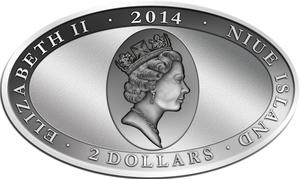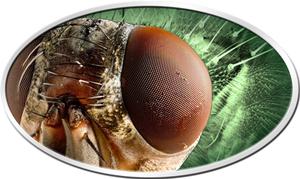Niue, a sovereign state in free association with New Zealand, uses two official legal tender currencies. The New Zealand Dollar is the circulation currency for daily transactions, while the government also authorises legal tender coins in the Niue Dollar currency for collector's purposes.
A number of mints issue a large variety of commemorative, bullion and collector coins under the authority of Niue. These coins are dedicated to historical or general popular culture themes not related to Niue itself. Many of them are in standard bullion sizes - typically, one ounce of silver (abbreviated as 1 oz Ag, where "Ag" comes from the Latin word for silver, Argentum). Many of these feature various animals.
This coin is the third release in the Animal Skins series and depicts the eye of a common House Fly.
Houseflies have dark grey or grey and yellow bodies with dark lines. The main part of their body has 8 segments in males and 9 segments in females. Females have 5 segments of their abdomen visible all the time. She sticks out the other 4 when she lays her eggs. This way, she can lay eggs under the surface. Females are a little bit bigger than males. Like all flies, they only have one pair of translucent wings for flying and the second pair are only used for balance. Houseflies are 4 to 8 mm long, and are 6.35 mm long on average.
Houseflies eyes are compound organs that are made of thousands of individual lenses. Compound eyes are capable of detecting both the popularisation of light and colour spectrum unseen by humans. Houseflies eyes can recognise even the slightest movements in a wide field. This allows the fly to see a far wider range, as well as detect and react to movement at a quicker pace than species with simple eyes. This is the reason that it is extremely difficult to swat a housefly. Houseflies are meticulous in their grooming, particularly around their eyes. These flies use their forelegs to remove any material that has come into contact with the eyes. | 



 Search for Niue: Silver Ounce 2014 Animal Skins - Housefly on eBay
Search for Niue: Silver Ounce 2014 Animal Skins - Housefly on eBay 

